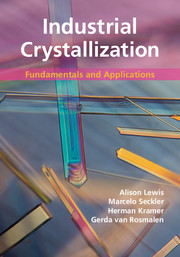Book contents
- Frontmatter
- Contents
- Nomenclature
- Industrial crystallization in practice: from process to product
- 1 Thermodynamics, crystallization methods and supersaturation
- 2 Characterization of a crystalline product
- 3 Basic process design for crystallization
- 4 Nucleation
- 5 Crystal growth
- 6 Agglomeration
- 7 The population balance equation
- 8 Batch crystallization
- 9 Measuring techniques
- 10 Industrial crystallizers
- 11 Precipitation and anti-solvent crystallization
- 12 Melt crystallization
- 13 Additives and impurities
- 14 Polymorphism
- Index
- References
9 - Measuring techniques
Published online by Cambridge University Press: 05 July 2015
- Frontmatter
- Contents
- Nomenclature
- Industrial crystallization in practice: from process to product
- 1 Thermodynamics, crystallization methods and supersaturation
- 2 Characterization of a crystalline product
- 3 Basic process design for crystallization
- 4 Nucleation
- 5 Crystal growth
- 6 Agglomeration
- 7 The population balance equation
- 8 Batch crystallization
- 9 Measuring techniques
- 10 Industrial crystallizers
- 11 Precipitation and anti-solvent crystallization
- 12 Melt crystallization
- 13 Additives and impurities
- 14 Polymorphism
- Index
- References
Summary
Why this chapter is important
Industrial crystallizers may be seen as devices that create a certain level of supersaturation as the driving force for the generation of the product crystals. Measurement of the supersaturation is therefore of paramount importance to control crystallization processes, as it determines the mechanisms and the rates of elementary crystallization processes such as nucleation, crystal growth and agglomeration. These elementary processes eventually lead to the formation of crystals of a wide spectrum of sizes. The so-called crystal size distribution (CSD), or more generally particle size distribution (PSD), is also a very important product characteristic that not only determines the performance of the crystalline product, but also the efficiency of the downstream processes like filtration and drying, as well as product stability during storage, as explained in Chapter 2.
In this chapter, you will learn various techniques used to measure the supersaturation and the CSD/PSD. In addition, you will have the knowledge to select the most convenient measuring technique according to a given measuring objective and crystallization system. With these tools, you will be able to understand and improve the process as well as the product quality of an industrial crystallization process.
Sampling and dilution procedures
Process measurements can be classified according to the sampling procedure: (a) inline, with a probe inserted in the process; (b) online, recirculating a side stream between the process and the instrument; (c) offline, in a laboratory. In the latter two procedures, a suspension sample must be withdrawn from the crystallizer, diluted and sometimes separated into solids and pure liquid. For the solids characterization, careful attention has to be paid to these procedures; otherwise the measurements are drastically affected (Allen, 2003, Gerla, 1995, Jager, 1990).
- Type
- Chapter
- Information
- Industrial CrystallizationFundamentals and Applications, pp. 192 - 209Publisher: Cambridge University PressPrint publication year: 2015



